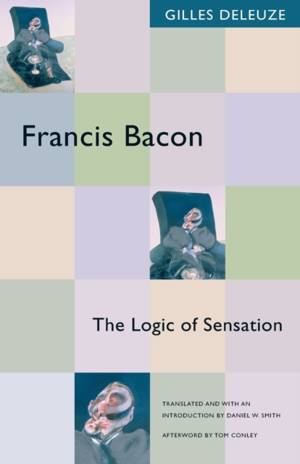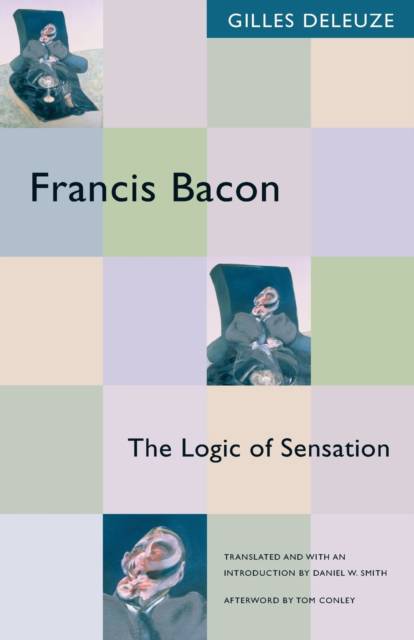
- Afhalen na 1 uur in een winkel met voorraad
- Gratis thuislevering in België vanaf € 30
- Ruim aanbod met 7 miljoen producten
- Afhalen na 1 uur in een winkel met voorraad
- Gratis thuislevering in België vanaf € 30
- Ruim aanbod met 7 miljoen producten
Zoeken
€ 39,45
+ 78 punten
Uitvoering
Omschrijving
Translated and with an Introduction by Daniel W. Smith
Afterword by Tom Conley Gilles Deleuze had several paintings by Francis Bacon hanging in his Paris apartment, and the painter's method and style as well as his motifs of seriality, difference, and repetition influenced Deleuze's work. This first English translation shows us one of the most original and important French philosophers of the twentieth century in intimate confrontation with one of that century's most original and important painters. In considering Bacon, Deleuze offers implicit and explicit insights into the origins and development of his own philosophical and aesthetic ideas, ideas that represent a turning point in his intellectual trajectory. First published in French in 1981, Francis Bacon has come to be recognized as one of Deleuze's most significant texts in aesthetics. Anticipating his work on cinema, the baroque, and literary criticism, the book can be read not only as a study of Bacon's paintings but also as a crucial text within Deleuze's broader philosophy of art. In it, Deleuze creates a series of philosophical concepts, each of which relates to a particular aspect of Bacon's paintings but at the same time finds a place in the "general logic of sensation." Illuminating Bacon's paintings, the nonrational logic of sensation, and the act of painting itself, this work--presented in lucid and nuanced translation--also points beyond painting toward connections with other arts such as music, cinema, and literature. Francis Bacon is an indispensable entry point into the conceptual proliferation of Deleuze's philosophy as a whole. Gilles Deleuze (1925-1995) was professor of philosophy at the University of Paris, Vincennes-St. Denis. He coauthored Anti-Oedipus and A Thousand Plateaus with Félix Guattari. These works, as well as Cinema 1, Cinema 2, The Fold, Proust and Signs, and others, are published in English by Minnesota. Daniel W. Smith teaches in the Department of Philosophy at Purdue University.
Afterword by Tom Conley Gilles Deleuze had several paintings by Francis Bacon hanging in his Paris apartment, and the painter's method and style as well as his motifs of seriality, difference, and repetition influenced Deleuze's work. This first English translation shows us one of the most original and important French philosophers of the twentieth century in intimate confrontation with one of that century's most original and important painters. In considering Bacon, Deleuze offers implicit and explicit insights into the origins and development of his own philosophical and aesthetic ideas, ideas that represent a turning point in his intellectual trajectory. First published in French in 1981, Francis Bacon has come to be recognized as one of Deleuze's most significant texts in aesthetics. Anticipating his work on cinema, the baroque, and literary criticism, the book can be read not only as a study of Bacon's paintings but also as a crucial text within Deleuze's broader philosophy of art. In it, Deleuze creates a series of philosophical concepts, each of which relates to a particular aspect of Bacon's paintings but at the same time finds a place in the "general logic of sensation." Illuminating Bacon's paintings, the nonrational logic of sensation, and the act of painting itself, this work--presented in lucid and nuanced translation--also points beyond painting toward connections with other arts such as music, cinema, and literature. Francis Bacon is an indispensable entry point into the conceptual proliferation of Deleuze's philosophy as a whole. Gilles Deleuze (1925-1995) was professor of philosophy at the University of Paris, Vincennes-St. Denis. He coauthored Anti-Oedipus and A Thousand Plateaus with Félix Guattari. These works, as well as Cinema 1, Cinema 2, The Fold, Proust and Signs, and others, are published in English by Minnesota. Daniel W. Smith teaches in the Department of Philosophy at Purdue University.
Specificaties
Betrokkenen
- Auteur(s):
- Uitgeverij:
Inhoud
- Aantal bladzijden:
- 224
- Taal:
- Engels
Eigenschappen
- Productcode (EAN):
- 9780816643424
- Verschijningsdatum:
- 1/05/2005
- Uitvoering:
- Paperback
- Formaat:
- Trade paperback (VS)
- Afmetingen:
- 137 mm x 215 mm
- Gewicht:
- 276 g

Alleen bij Standaard Boekhandel
+ 78 punten op je klantenkaart van Standaard Boekhandel
Beoordelingen
We publiceren alleen reviews die voldoen aan de voorwaarden voor reviews. Bekijk onze voorwaarden voor reviews.











